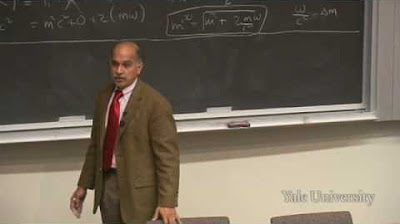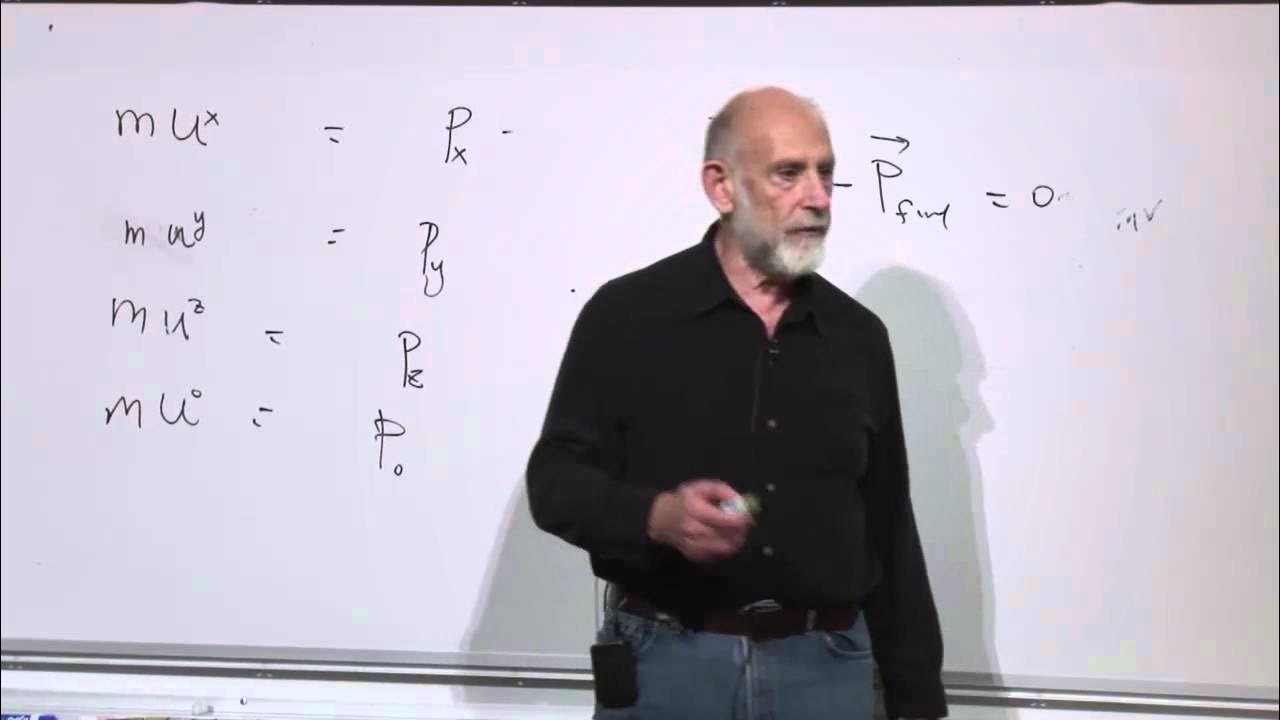Why does E=MC²?
TLDRThis script delves into the fundamental concepts of momentum and energy conservation, highlighting Einstein's famous equation E=mc^2. It explains the relativistic nature of mass and energy, emphasizing that momentum is conserved regardless of the observer's frame of reference. The video explores the idea of converting mass into light, illustrating how mass and energy are intrinsically linked through the constant speed of light in space-time. It concludes by discussing the practical implications of this theory, ensuring the conservation of energy across different frames of reference.
Takeaways
- 📚 Momentum is a fundamental concept that must be accepted as conserved in the universe, despite the lack of a known reason.
- 🌌 The equation E=mc² represents the equivalence of mass and energy, suggesting that all mass could theoretically be converted into light or other forms of energy.
- 🚀 Momentum is defined as mass times velocity, indicating that an object with zero velocity still has momentum from the perspective of other observers.
- 🌐 The concept of 'motionlessness' is relative, as every object is in motion from some frame of reference, including moving with the Earth or being perceived by observers on the opposite side of the world.
- 👨🏫 The script introduces a German physicist who questioned the relativity of energy, leading to the derivation that light always travels at the speed of light regardless of the observer's motion.
- 🕊️ The relationship between space and time was explored by another German physicist, who proposed a four-dimensional reality known as space-time or Minkowski space.
- 🔄 In this four-dimensional space-time, all objects move at a constant speed, challenging the traditional understanding of varying velocities through space.
- 🌀 The script explains that the conservation of momentum in a system must consider both the magnitude and direction of the momentum, which can change upon collision.
- 🌈 E=mc² is presented as a way to describe the energy released if all mass were converted into massless energy, such as photons.
- 🔬 The script discusses the practical implications of E=mc² in scenarios like fission reactions, where mass is converted into kinetic energy, and the relativistic effects on the observer's perception of this energy.
- 🌍 The concept of a 'proper frame' is introduced, where an observer perceives themselves as stationary in space but moving through time at the speed of light, illustrating the deeper meaning of E=mc².
Q & A
What are the two fundamental truths mentioned in the script that one must accept to understand the equation?
-The two fundamental truths are that momentum is conserved in the universe for reasons unknown, and the right side of the equation equals energy only if all mass is converted into something massless, such as a photon or light.
Why is it necessary to think of mass as being converted into light when considering the equation?
-Converting mass into light simplifies the concept by considering a common massless entity, the photon, which allows us to visualize the equation as the amount of light energy that would be produced if all mass were converted into light.
What is the definition of momentum in the context of the script?
-Momentum is defined as the ferocity of an object's motion through space and is calculated as the product of mass and velocity.
Why is it impossible to have an object with zero velocity according to the script?
-It is impossible because from any given perspective, there will always be another observer who sees the object as moving, making the concept of zero velocity relative and not absolute.
Who is the 'rando German' mentioned in the script, and what did he demonstrate?
-The 'rando German' refers to Albert Einstein. He demonstrated that light will always be the speed of light regardless of the motion of the observer, leading to the conclusion that there must be a unique relationship between space and time.
What is the significance of Minkowski space in the script's explanation of the equation?
-Minkowski space, or space-time, is significant because it introduces the concept of a four-dimensional reality where objects move at a constant speed through space-time, which is essential for understanding the conservation of energy and momentum.
What is the norm of four-momentum, and why is its directionless nature important?
-The norm of four-momentum is a directionless momentum that describes the momentum of an object through space-time. Its directionless nature is important because it allows for the conservation of momentum without considering direction, which is crucial for understanding the equation E=mc^2.
Why is the equation E=mc^2 relevant to the conservation of energy in different frames of reference?
-The equation E=mc^2 is relevant because it elegantly explains the absolute energy that would be released if mass were converted into energy, ensuring that energy is conserved across different frames of reference, even when velocities are relativistic.
How does the script explain the relativistic nature of kinetic energy in fission reactions?
-The script explains that due to relativistic velocities, an observer may perceive particles moving at a different speed than they actually are. This is reconciled by the understanding that all energy moves through space-time with a constant speed, ensuring energy conservation.
What is the 'proper frame' mentioned in the script, and why is it significant?
-The 'proper frame' is a frame of reference where the observer is motionless in space but moving through space-time at the speed of light. It is significant because it allows for the understanding of how energy and mass move through space-time and how E=mc^2 applies to this movement.
How does the script summarize the concept of E=mc^2 in relation to the observer's frame of reference?
-The script summarizes that the amount of energy something with mass or a frame of reference has is relative to the observer's frame of reference. However, when energy or mass is described without a frame of reference, such as light or momentum through space-time, E=mc^2 provides an absolute measure of energy.
Outlines
📚 Fundamental Concepts of Momentum and Energy Conservation
This paragraph introduces the fundamental concepts of momentum and energy conservation, emphasizing the acceptance of two truths: the conservation of momentum in the universe and the conversion of mass into energy. It explains the equation E=mc² as a representation of the light energy that would be produced if all mass were converted into light, a massless entity. The paragraph delves into the concept of momentum, its relativity, and the historical exploration of space-time by German physicists, leading to the understanding of four-dimensional reality and the constant speed of light. It concludes by connecting the traditional conservation of momentum with the four-dimensional space-time perspective, introducing the concept of four-momentum.
🌌 The Relativity of Energy and the E=mc² Equation
The second paragraph explores the practical implications of converting mass into energy, particularly in fission reactions where mass is often released as kinetic energy. It discusses the relativistic effects on the observation of such reactions, highlighting how the perceived velocity of particles is influenced by the observer's frame of reference. The paragraph explains how the concept of four-momentum and the constant speed of energy through space-time (C) allows for the conservation of energy across different frames of reference. It concludes by emphasizing that E=mc² describes the absolute energy that would be released if mass were completely converted into massless energy, such as photons, and how this equation transcends the relative perceptions of energy in lower-dimensional viewpoints.
Mindmap
Keywords
💡Momentum
💡Conservation of Momentum
💡Massless Entity
💡Einstein's Equation (E=mc^2)
💡Space-Time
💡Four-Momentum
💡Relativistic Mass
💡Fission Reaction
💡Frame of Reference
💡Maxwell's Equations
💡Norm of Four-Momentum
Highlights
Momentum is a fundamental concept that is conserved in the universe.
The equation E=mc^2 implies that all mass can be converted into energy, specifically light energy.
Momentum is defined as mass times velocity, indicating motion through space.
The concept of zero velocity is challenged by the idea that all objects are in motion relative to some observer.
Maxwell's equations and the constancy of the speed of light led to the understanding of a unique relationship between space and time.
Minkowski space, or space-time, is a four-dimensional reality where objects move at a constant speed.
The norm of four-momentum is introduced as a directionless momentum in space-time.
Conservation of momentum traditionally includes direction, but in space-time, it is directionless.
E=mc^2 can be seen as the energy of a photon, or light, if all mass were converted into energy.
Mass to energy conversion doesn't always result in light; it can manifest as kinetic energy in fission reactions.
Relativistic mass and the perception of kinetic energy can vary depending on the observer's velocity.
The concept of space-time with a constant speed C helps to preserve the conservation of energy across different frames of reference.
Momentum, when multiplied by C, describes the directionless momentum of mass or energy through space-time.
The norm of four-momentum needs to be squared because it results in a scalar value without direction.
A proper frame of reference is one where the observer perceives themselves as motionless in space.
E=mc^2 explains the absolute energy that would be released if mass were fully converted into energy, independent of the observer's frame.
Transcripts
Browse More Related Video

Deriving Einstein's most famous equation: Why does energy = mass x speed of light squared?

15. Four-Vector in Relativity

Kinetic Energy EXPLAINED in 5 Levels - Beginner to Advanced (Classical Physics by Parth G)

Special Relativity | Lecture 3

Why speed of light results in E = mc^2 ? [Einstein's original proof]

Why light has energy, but no mass? (Understanding E = mc2)
5.0 / 5 (0 votes)
Thanks for rating: